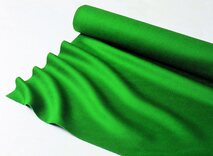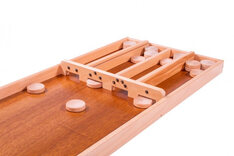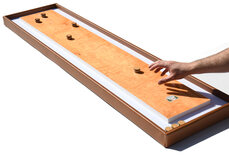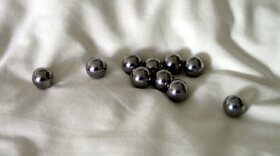The Rules of Bagatelle
The following is a basic set of instructions for friendly play of the game of Bagatelle. There has never been any authoritative national body dictating standard for Bagatelle and so a variety of different tables and rules have appeared across England during the last few centuries. For clarity, the Victorian game is given as dictated by Hoyle followed by the two current versions, both of which can be found in pubs in certain localised areas of England. There is also a section on Parlour Bagatelle for those interested in the miniaturised indoor version of the game. Finally, three variations of Bagatelle played with the addition of arches are given. Note: 1 foot = 30.48 cm.
See also: Bagatelle Games.
Bagatelle Generalities
A Bagatelle table is of a similar form to a Billiards table - normally slate or Mahogany bed, cloth covered with cushions and measuring 6 - 10 feet long and 2 - 3 feet wide. The first major difference from a billiard table is that one end is rounded instead of square. The second diversion is that instead of pockets around the edge, the primary focus is upon the nine holes sunk into the table at the semi-circular end (in the manner of Bar Billiards), one in the middle of the semi-circle and the rest surrounding it evenly in a ring. The central cup is numbered 9, the others are numbered 1 - 8 in what appears at first to be a semi-random order. However, the common (possibly compulsory) pattern is, starting from the bottom and working clockwise, 1, 4, 8, 3, 5, 2, 7, 6. It may or may not be coincidence that the top three numbers, the bottom 3 numbers and the middle 3 numbers all sum to 15.
Rather like a Billiards table, Pool table or Darts board, a variety of games can be played on a Bagatelle table but all involve the players standing at the square end of the table and hitting the balls with a tipped cue towards the holes at the other end.
The old game of Bagatelle featured 8 white balls and 1 black ball which started on the middle spot. Later variants were played with the black in the same way but 1 player played 4 white balls, the other player played 4 red balls. The game played in certain parts of Southern England features 2 reds instead of a black and 7 whites.
In these games, players would normally 'string' for the lead. Each player would strike a single ball up the empty table. The player who achieves the highest score starts the game. (Masters Games optional rule - in the event of a draw, string again but with the additional rule that the ball must bounce off one cushion before entering a cup; in the event of another draw, require that 2 cushions must be struck before scoring and so on).
Victorian Bagatelle
These are the rules that were played during the 1800s "according to Hoyle" - in fact these were probably written by one Professor Huffman towards the close of the nineteenth century. Tables were typically around 8 x 2 feet and did not feature pockets. Balls were supposed to be exactly the same diameter as the cups and were one black and either eight white or four red and four white. Balls were propelled either by a cue or a mace (a long stick with a flat pushing block on one end).
To begin, the black ball is placed on the middle spot. Each turn consists of a player playing all eight balls down the table towards the cups.
The first ball must strike the black ball. If it does not, the ball is removed from the table, does not score and the player tries again in the same way until the black ball is moved. Balls must be played from the front spot until the black ball is struck. Thereafter, balls can be played from anywhere behind the front spot and it is not necessary to strike the black ball or any other ball.
Any ball that returns more than half way down the table is removed for the remainder of the turn.
The aim is to pot as many balls as possible in the cups, scoring points according to the value indicated in the cup. The black scores double points and so ideally will be deposited into the highest scoring cup in the middle thus scoring 18 points. The maximum score is therefore 54 points.
The game is usually played to 120 points. However, if it is the first player who reaches the target first, that player must complete his turn and the second player must also complete a turn to ensure fairness. Once the second player has finished, the player with the highest score, wins.
Sans Egal
This game requires 4 reds, 4 whites and the black, one player playing only reds, the other only whites. The black ball is placed on the middle spot and players take turns to play one ball alternately.
As with Bagatelle, the first ball must strike the black first. If it fails to do so, it is not removed from the table but the player forfeits 5 points and does not score anything should the ball drop into a hole. In this case, the onus for striking the black ball then falls to the opponent.
If a player knocks an opponent's ball into a pocket, the ball is scored for the opponent. Other rules are played in the same way as for Victorian Bagatelle.
The highest scorer after playing all 4 balls wins unless it has been agreed that the game should be for a specific number of points - typically 25 or 31.
Sans Egal - Variant
Every ball played must first strike the black until the black is holed.
The player who scores the black scores the value of that hole plus the value of any of his own balls already holed (whether by himself or the opponent).
Northern Bagatelle
The game played on what will be referred to as the 'Northern Bagatelle table' is most popular in and around Chester. A table measures 8 feet x 2 feet, 9 inches and is without pockets. There are eight white balls and one black ball (sometimes there are 4 reds & 4 whites but both colours are treated identically so this has no effect on the game). This game is the direct ancestor of old English Bagatelle described above. To begin, the black ball is placed on the middle spot. Each turn is called a "stick" and consists of a player playing all eight balls down the table towards the cups. The cue ball must be played from the spot near the front of the table.
- If the black ball is on the table, then the cue ball must strike the black ball and it must strike it first before entering a cup or striking another ball.
- Once the black ball is potted, each cue ball must strike another white ball before
- If there are no un-potted balls on the table, then the cue ball must strike a cushion.
Southern Bagatelle (with 2 reds and pockets)
Equipment
The game in Southern England, most notably in Coventry and Bristol, is played upon tables are larger usually at 10 x 3 feet and feature two side pockets about three quarters of the way up on either side. There are seven white balls and two red balls. The two reds begin on spots situated on either side of the table just in front of the cups.
Play
The cue balls are placed on the spot at the front of the table and then played up the table towards the cups. Before each stroke, the player must nominate the cup or pocket that he/she intends to aim at.
- If a red ball is on the table, then the cue ball must strike a red ball and it must strike one before entering a cup or striking another ball.
- Once both red balls are potted, each cue ball must strike another white ball.
- If there are no un-potted balls on the table, then the cue ball must strike a cushion.
Mississipi
This game was played on a Bagatelle table without pockets but with the addition of a set of numbered arches that span the table across its width just in front of the circle of cups. The arches can vary but a typical arrangement would be be 6-4-1-7-8-2-5-3, the numbers giving the score made by a ball passing through the arch. The game is played with nine balls of any colour and any number of players. Players should string for the lead uses the arch scores to decide who starts.
- Players take turns to strike all nine balls in succession up the table.
- Each ball that passes completely through an arch having first struck a cushion scores the amount indicated above the arch.
- A ball that strikes a cushion but does not pass through an arch stays on the table but, if a subsequent ball knocks it through an arch, it scores accordingly.
- If a ball does not strike a cushion or rebounds back behind the cueing line or leaves the table, it is removed from play for the duration of the turn.
- If a ball passes through an arch without first hitting a cushion, the score made by that ball is given to each of the opponents scores instead.
La Trou Madame
This simpler game is played in exactly the same way as Mississipi except that it is not required to hit a cushion before entering an arch.
Mississipi/La Trou Madame - Variation
An alternative version is played in the same way but any ball that, having passed through an arch, also fall into a cup scores the value of the cup in addition to any points scored by passing through an arch. Masters Games suggests that while this might add an unwelcome element of luck to Mississpi, it might favourably enhance La Trou Madame.
These rules are provided by Masters Traditional Games, an Internet shop selling quality traditional games, pub games and unusual games. For general information or for copying and copyright, see our Rules Information page.
Our rules are comprehensive instructions for friendly play. If in doubt, always abide by locally-played or house rules.
Copyright James Masters, 2025. All rights reserved.








































